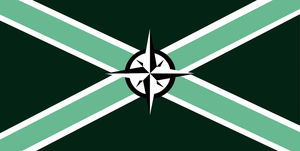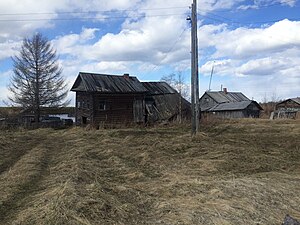Koskenkorva: Difference between revisions
mNo edit summary |
m Updating for Kirav 4.0 |
||
| Line 26: | Line 26: | ||
| '''[[Federal Stanora|Stanora]] seats''' || 3 | | '''[[Federal Stanora|Stanora]] seats''' || 3 | ||
|- | |- | ||
| '''Official languages''' || Koskenkorvan Coscivian<br>Fenno-Koskenkorvan | | '''Official languages''' || High Coscivian<br>Koskenkorvan Coscivian<br>Fenno-Koskenkorvan | ||
|- | |- | ||
| '''Postal Abbreviation''' || KKK | | '''Postal Abbreviation''' || KKK | ||
| Line 38: | Line 38: | ||
[[Category:Kiravian islands]] | [[Category:Kiravian islands]] | ||
'''Koskenkorva''' is an island state of the [[Kiravian Federacy]] located to the northeast of [[Great Kirav]] in the Sea of Valēkas. | '''Koskenkorva''' is an island state of the [[Kiravian Federacy]] located to the northeast of [[Great Kirav]] in the Sea of Valēkas. | ||
==History== | ==History== | ||
The history of [[Coscivian civilisation]] in Ixnay begins on Koskenkorva. The | The known history of the [[Coscivian civilisation#People|Coscivian peoples]] in Ixnay begins on Koskenkorva. The earliest evidence of human habitation dates back 20,000 to 30,000 years. | ||
===Cromwelute Wars=== | ===Cromwelute Wars=== | ||
===Kilikas Renaissance and Early Modernity=== | |||
=== | ===Federalist Period=== | ||
=== | ===Kirosocialism=== | ||
Kirosocialism held little appeal for the average Koskenkorvan, given its limited industrial development and widespread collective village ownership of land. The ''Xēmbra'' denounced the declaration of the [[Kiravian Union]] and the island became a safe haven for loyalist Kiravian Navy ships fleeing the Northeastern naval bases, as well as for anti-communist emigrés. Koskenkorva remained a Federalist stronghold until after the defeat of the [[Farravonian Counterrevolution]] in [YEAR] left Kirosocialist forces free to finally mount an assault on the island. The rump KFR government based in [[Æonara]] could no longer realistically maintain its lines of communication and was forced to evacuate its forces. Many emigrés, some being displaced for the second time, were able to escape to [[Suderavia]] and [[Scapa]]. Valkadun, which had seen its coastal defence artillery lifted by the retreating Federalist troops, surrendered to the Red Fleet without firing a shot. The Xēmbra fled inland to Kosovo and attempted to rally a militia to resist the invaders, but the lightly-armed and poorly-organised Koskenkorvan militia proved no match for Red Army shock troops. Most of the remaining loyalist government was captured at Kosovo or the northern village of Hyaloñ in [Month] [Year], and the Xēmbra was collectively tried and publically executed in Valkadun in [Month]. A low-level guerilla insurgency would continue in densely-forested backwoods areas. | |||
An already poor and remote region, Koskenkorva would not fare well under Kirosocialist rule. The island was declared off-limits to foreign trade and visitors, and even travel by KU citizens was tightly restricted by the Ministry of Public Security. | |||
===Reunification=== | ===Reunification=== | ||
==Society & Culture== | ==Society & Culture== | ||
{{bar box | {{bar box | ||
|title=<center>Ethnocultural Breakdown</center> | |title=<center>Ethnocultural Breakdown</center> | ||
Revision as of 13:27, 6 February 2022
| Koskenkorva | |
 Flag | |
| Country | Kiravian Federacy |
| Capital and largest city |
Valkadun |
| Population | 5,522,850 |
| First Executive | Íoxanen S.D.L. Sölvakiur |
| Chancellor | Þylatur K.R.I. Xalivorn |
| Stanora seats | 3 |
| Official languages | High Coscivian Koskenkorvan Coscivian Fenno-Koskenkorvan |
| Postal Abbreviation | KKK |
Koskenkorva is an island state of the Kiravian Federacy located to the northeast of Great Kirav in the Sea of Valēkas.
History
The known history of the Coscivian peoples in Ixnay begins on Koskenkorva. The earliest evidence of human habitation dates back 20,000 to 30,000 years.
Cromwelute Wars
Kilikas Renaissance and Early Modernity
Federalist Period
Kirosocialism
Kirosocialism held little appeal for the average Koskenkorvan, given its limited industrial development and widespread collective village ownership of land. The Xēmbra denounced the declaration of the Kiravian Union and the island became a safe haven for loyalist Kiravian Navy ships fleeing the Northeastern naval bases, as well as for anti-communist emigrés. Koskenkorva remained a Federalist stronghold until after the defeat of the Farravonian Counterrevolution in [YEAR] left Kirosocialist forces free to finally mount an assault on the island. The rump KFR government based in Æonara could no longer realistically maintain its lines of communication and was forced to evacuate its forces. Many emigrés, some being displaced for the second time, were able to escape to Suderavia and Scapa. Valkadun, which had seen its coastal defence artillery lifted by the retreating Federalist troops, surrendered to the Red Fleet without firing a shot. The Xēmbra fled inland to Kosovo and attempted to rally a militia to resist the invaders, but the lightly-armed and poorly-organised Koskenkorvan militia proved no match for Red Army shock troops. Most of the remaining loyalist government was captured at Kosovo or the northern village of Hyaloñ in [Month] [Year], and the Xēmbra was collectively tried and publically executed in Valkadun in [Month]. A low-level guerilla insurgency would continue in densely-forested backwoods areas.
An already poor and remote region, Koskenkorva would not fare well under Kirosocialist rule. The island was declared off-limits to foreign trade and visitors, and even travel by KU citizens was tightly restricted by the Ministry of Public Security.
Reunification
Society & Culture
Koskenkorva represents a unique cultural fusion of Coscivian and Finnic culture. In the centuries since the Cromwelute Wars, the Koskenkorvan Coscivians and Fenno-Koskenkorvans have come to generally consider themselves a single people differentiated into Coscivian-speaking and Finnic-speaking communities. Koskenkorvans account for over 90% of the state's population, with about 55% of the total being primarily Finnic-speaking and 35% of the total primarily speaking Koskenkorvan Coscivian. Due to linguistic and local administrative reforms in the 21190s, individuals can only report themselves as Fennophone, Coscophone, or Other/Deaf for administrative purposes such as school enrolment and internal passports. However, an estimated 6-10% of ethnic Koskenkorvans are natively bilingual, many of whom were raised in cross-linguistic households.
For federal statistical and affirmative action purposes, Coscivian-speaking Koskenkorvans are classified as Coscivians, whereas Finnic-speaking Koskenkorvans are placed in the National Minority category. The state government does not recognise this distinction.
The largest religious body in Koskenkorva is the Koskenkorvan People's Church, a high-church Lutheran denomination. It is adhered to by some 65% of the population. Other major Christian denominations include the Coscivian Orthodox, Roman Catholic, and Insular Apostolic churches.
Koskenkorvans are stereotyped as laconic, earthy, tough, solitary, and rather depressed, as shaped by their harsh environment, tumultuous history, and dismal weather.


Economy
Farming, fishing, lumbering and mining are the historical mainstays of the Koskenkorvan economy. Over one-third of Koskenkorvan households are directly involved in fishing or agriculture. Most agriculture is for subsistence purposes, growing staples such as cale, potatoes, chickens, hogs, and mushrooms.
Since reunification with Kiravia, tourism has grown into a major industry in Koskenkorva, with thousands of mainland Kiravians travelling to visit the state's pristine lakes, breathtaking seaside cliffs and fjords, Coscivian historical sites, and puffin colonies. This tourism trade has also given rise to cottage industries in handicrafts, local pastries, and mead.
Meridiælum SAK, headquartered in Kārtulin, is the second-largest Kiravian producer of bottled water, most of which is sourced from springs and aquifers in Koskenkorva.

Energy
10% of electrical energy in Koskenkorva is generated by the combustion of peat, which is abundant across most of the island. Peat is also the main fuel used for domestic heating. Peat extraction is conducted by most rural households in an artisanal fashion, either individually or (more commonly in the northern parts of the island) on a local coöperative basis. More sophisticated commercial peat-cutting operations also exist. Peat resources in Koskenkorva are regulated by a dedicated agency of the state government reporting to the Secretary of Peat.
Politics
Like all Kiravian states, Koskenkorva is a constitutional republic, and is regarded as the most direct-democratic state after New Harbour. Legislative responsibility is divided between the Hearing, an open legislative forum open to all adult, citizen males able to attend its biannual sessions at the vernal and autumnal equinoxes, and the General Court of Koskenkorva, a more conventional legislature elected every two years by alternative vote. Executive power belongs to the First Executive of Koskenkorva, who is appointed by the Prime Executive of the Kiravian Federacy on the advice of the General Court, until 21220 when the position will be filled by direct popular election.
There are four classes of municipal governments in Koskenkorva: Cities, towns, hundreds, and villages. Towns, hundreds, and villages operate as direct democracies.
| Party Name | General Court | Federal Caucus | Platform | |
|---|---|---|---|---|
| Koskenkorvan Civil Union Koskenkorvax Þóliþūra |
34 / 80 |
SRA | Conservative liberalism, Shaftonist democracy, Koskenkorvan subnationalism, Bilingualism | |
| New Community Party - Finnic People's Party Inox Skámiplaiduv - Svómix Plānoplaiduv |
21 / 80 |
non-inscrit | Centrism, Finnic-speakers' interests | |
| Independent Party Suluanþix Plaiduv |
10 / 80 |
KFA | Agrarianism, Localism, Fishermens' interests, Soft antifederalism | |
| Christian Political Party Xristūrisēx Ostraplaiduv |
6 / 80 |
CSU | Distributism, Christian democracy | |
| Independents |
9 / 80 |
-- | -- | |
| Social Democratic Party Soksàliþéruārkarisēx Plaiduv |
2 / 80 |
NDA | Social democracy |
Government Ministries: Secretariat of State Affairs - Responsible for external affairs, state protocol, civil registration, trade and tourism initiatives, commercial regulation, and electoral matters.
Secretariat of Defence - Responsible for the Koskenkorvan Armed Forces and militia.
Secretariat of Public Security - Responsible for state police, civil defence, and emergency management.
Secretariat of Peat - Responsible for managing peat resources and peat bog conservation.
Secretariat of Fisheries & Marine Resources - Pretty much what you'd expect